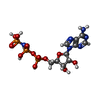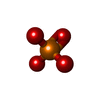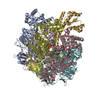+Search query
-Structure paper
| Title | The molecular structure of an axle-less F-ATPase. |
|---|---|
| Journal, issue, pages | Biochim Biophys Acta Bioenerg, Vol. 1866, Issue 1, Page 149521, Year 2024 |
| Publish date | Oct 18, 2024 |
 Authors Authors | Emily J Furlong / Ian-Blaine P Reininger-Chatzigiannakis / Yi C Zeng / Simon H J Brown / Meghna Sobti / Alastair G Stewart /  |
| PubMed Abstract | FF ATP synthase is a molecular rotary motor that can generate ATP using a transmembrane proton motive force. Isolated F-ATPase catalytic cores can hydrolyse ATP, passing through a series of ...FF ATP synthase is a molecular rotary motor that can generate ATP using a transmembrane proton motive force. Isolated F-ATPase catalytic cores can hydrolyse ATP, passing through a series of conformational states involving rotation of the central γ rotor subunit and the opening and closing of the catalytic β subunits. Cooperativity in F-ATPase has long thought to be conferred through the γ subunit, with three key interaction sites between the γ and β subunits being identified. Single molecule studies have demonstrated that the F complexes lacking the γ axle still "rotate" and hydrolyse ATP, but with less efficiency. We solved the cryogenic electron microscopy structure of an axle-less Bacillus sp. PS3 F-ATPase. The unexpected binding-dwell conformation of the structure in combination with the observed lack of interactions between the axle-less γ and the open β subunit suggests that the complete γ subunit is important for coordinating efficient ATP binding of F-ATPase. |
 External links External links |  Biochim Biophys Acta Bioenerg / Biochim Biophys Acta Bioenerg /  PubMed:39428050 PubMed:39428050 |
| Methods | EM (single particle) |
| Resolution | 3.0 - 3.72 Å |
| Structure data | EMDB-41811, PDB-8u1h: EMDB-43903, PDB-9avj: |
| Chemicals |  ChemComp-ANP:  ChemComp-MG:  ChemComp-ADP:  ChemComp-PO4: |
| Source |
|
 Keywords Keywords | HYDROLASE / ATPase / ATP synthase / MEMBRANE PROTEIN / electron transfer / ATP hydrolysis |
 Movie
Movie Controller
Controller Structure viewers
Structure viewers About Yorodumi Papers
About Yorodumi Papers








